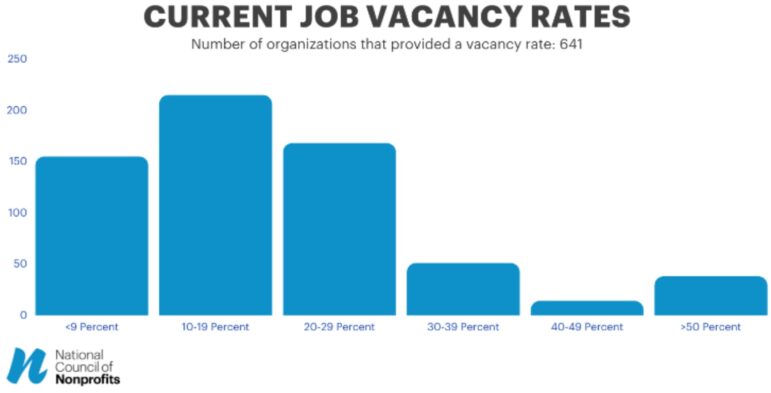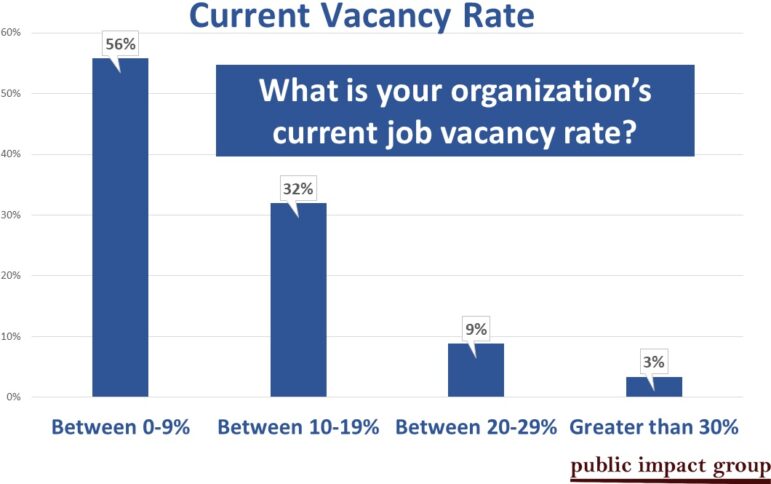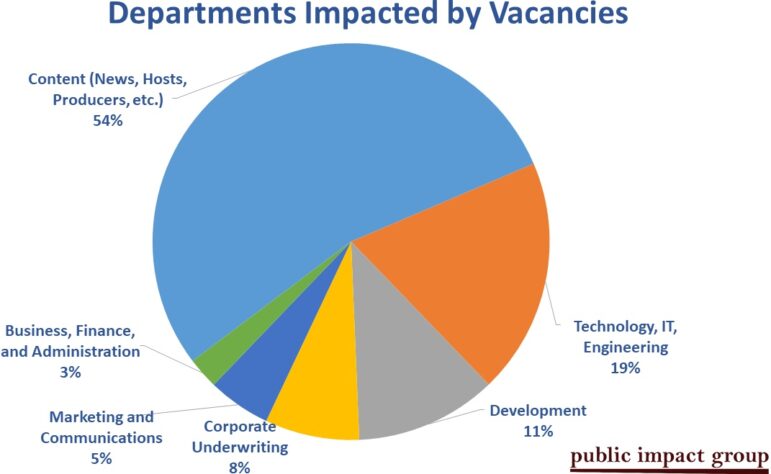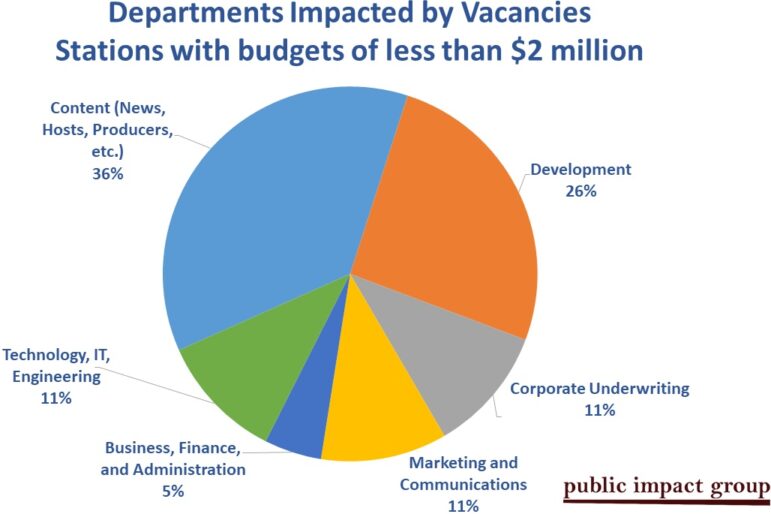Survey finds smaller stations anticipate hit from ‘The Great Resignation’

lorozco3D / iStock
This article has been adapted from Tim Eby’s “Three Things” newsletter.
I recently fielded a Public Media Staff Vacancy Survey to identify how much “The Great Resignation” has impacted public media organizations, primarily stations, and where the stress points are at stations and within key departments. I was intrigued to look into this issue after sharing the results of a survey conducted by the National Council of Nonprofits of 641 organizations in the fall of 2021. It found that four in 10 nonprofits surveyed were struggling with job vacancy rates of 20% or more.

To understand how public media organizations compare to this study, I sent a request through this newsletter with help from Current, which promoted the survey across various social media channels. The Public Radio Regional Organizations and the Station Resource Group also generously shared details of the survey with their members.
To get the most responses, we asked a few questions:
- What is the annual budget of your organization?
- What is your organization’s current job vacancy rate?
- Is there a specific department within your organization where the largest vacancy rates are occurring? And if so, what department?
- Do you anticipate your vacancy rate rising, falling or staying the same over the next six months?
We also asked for comments, and there were many — thank you!
After cleaning the data to make sure it came from legitimate organizations, we ended up with 147 completed surveys. Since my newsletter focuses more on public radio (although I greatly appreciate the number of public television leaders who subscribe), the most significant number of responses came from either joint licensees or public radio stations1. And with that out of the way, let’s do the numbers.
Thing One: The top-line results
Let’s start with who participated in the survey.

Of the 147 stations responding, smaller stations made up the bulk of the survey participants, reflecting the size distribution in the public media system as a whole.
But we had a good sampling across the five options ranging from budgets under $2 million to budgets of $12 million or more. Again, note the disclaimer above — these results do not represent all of public media, but they provide a good balance of stations for us to analyze.
Only 12% of the 147 organizations that responded have vacancy rates of more than 20%.

Given these results, compared to the survey of nonprofits completed last fall, you could easily say that public media is not in nearly the predicament of the nonprofit sector as a whole. And you might be right.
However, a deeper examination of the responses may raise at least a few red flags of concern. First, let’s look at small and medium-sized stations. Nearly a third of those stations had a vacancy rate of 10–19%.
If you have 15 staffers at your station, a vacancy rate of 15% would mean that you have at least two current full-time openings. Depending on what department those openings are in, the result is that there is some stress being felt at those organizations. We’ll dive into the data specifically for smaller stations in Thing Two.
We also asked if vacancies impacted a specific department, and over half responded that the most impacted area was content, including journalists, hosts and producers.

We typically do not have a lot of turnover. However, recently we’ve had a few people in content leave for other opportunities. We have also created a new position in content. We have been able to fill a few of the positions; however, we have three tough positions to fill.
That’s one comment from a manager at a large joint licensee responding to the survey, who added that the three positions they’re looking to fill are two radio announcer/producer jobs and a web developer.
A leader from a small radio station noted that “some of this has been natural attrition due to retirements and an aging staff. Some are just life changes. But some of this has been due to historically low salaries in our small shop. It’s difficult to compete in today’s environment to attract qualified people.”
Based on the comments offered by station leaders, providing competitive salaries to recruit and retain staff is a recurring challenge for many stations.
We also asked respondents whether they anticipated their station’s vacancy rate increasing, falling or staying the same over the next six months. Those responding were optimistic, with more than a third expecting the vacancy rate to go down and only 12% forecasting an increase.
In the following two “things,” we’re going to break down these numbers by station budget size, revealing some specific challenges facing small and larger organizations.
Thing Two: The constant churn of a small shop
We are a smaller organization, so just one or two employees leaving makes a big difference in our vacancy rates, also our ability to operate at normal capacity. So we have to have contingency/succession plans worked out to handle the new realities of staff movement.
One of the interesting takeaways from the responses to the survey is that more significant vacancy rates are happening at the two ends of the size spectrum of the organizations participating in the survey.
- Half of the stations with budgets of less than $2 million have vacancy rates of more than 10%, with 21% of the stations above the 20% vacancy rate.
- Of the largest stations, those with budgets of $12 million or more, 56%, are above the 10% vacancy rate threshold. This adds up to many openings for an organization in that size range.

Smaller stations are experiencing more churn in development departments than larger-budget organizations.
Many of these stations may have only one or two people working in fundraising, so an open staff position can significantly impact revenue growth.
A station leader recently shared with me that they were short of staff to get renewal mail out or organize telemarketing efforts, meaning that they had become too dependent on on-air pledge drives to raise money. Unfortunately, when there’s a lot of staff turnover, there are more and more stories like this at small operations.
This is certainly an issue for Greater Public working with Contributor Development Partnership and others to explore this issue with stations; the situation will probably only worsen over time. Scale matters, particularly when it comes to fundraising.
Keeping salaries competitive is also a major issue at many small stations. A leader at a station with a budget under $2 million lamented this problem, with the need to grow revenue to cover the increasing expenses of higher salaries:
We have a number of new positions open and are having a difficult time attracting qualified candidates. We anticipate having to review and potentially raise salaries across the board. Even more entry level candidates are requesting higher wages. We also need to improve our benefits package to include retirement plans, etc. This will all require increased revenues.
One GM of a smaller-market station commented that the biggest staffing issue facing that organization is the higher cost of living in their area. This makes it difficult to bring in people with public media experience.
We pay our news director $50,000-$60,000/year, so that position is a revolving door. The first hire already lived here, and had TV news anchor experience, but did an amazing job for 3 years. He moved to on to a larger market and tripled his salary as a news anchor, not news director. The next person rented a converted garage to live and then moved to a journalism startup in a larger market with a huge salary increase.
Stations of all sizes are aggressively seeking to hire content staff. A big focus has been the challenge of increasing the pool of diverse candidates and, for some university-licensed stations, the process gets slowed down by bureaucracy not aligned with the media moment.
We are filling positions, but the process is very slow due to a new reorganization of our HR department which has created procedural learning curve issues, and what seems like a shortage of candidates. I expect some vacancies to come up in other areas of the network, as younger employees are maturing and seeking salaries we can’t afford. What worries me is the fact that there are fewer young “newbies” applying to replace them. I also worry about the general national “malaise” or feeling of helplessness that seems to permeate lives in general — and may be part of the reason for “the great resignation.”
Another manager shared a similar frustration as the result of their institution’s hiring policies and procedures:
Universities add levels of bureaucracy that can add delays and restrictions. Positions remain open for too long; merit raises are difficult; change to job descriptions difficult; freelancers and contractors are not easy to hire or get paid, etc.
Thing three: Where’s the pipeline for broadcast engineers?
Another takeaway from the survey has been flying under the radar for a while: the need to create a pipeline for broadcast engineers.
Current took on this subject in a story in January 2021, in which several stations reported challenges in recruiting qualified applicants.
The survey results reflected that many stations, particularly larger ones, struggle to fill engineering and technology positions. Among the largest stations responding, 40% said that their technology/engineering department felt the vacancy challenge the most.

It was perhaps then a coincidence that when the Public Media Staff Vacancy Survey was being pushed out to stations, the issues over the need for this specific area of expertise created a good bit of interest on the AREPS email list for leaders at NPR member stations.
Jennifer Ferro, president of KCRW in Santa Monica, Calif., offered an idea to explore “the creation of an engineering apprenticeship to help our industry.” She further explained that the concept could be modeled after a fellowship program that KCRW has for reporters/producers of color that spans 18 months, provides a full-time salary and health benefits, and comes with a supervised apprenticeship.
“The goal is to create the workforce we need,” Ferro said.
Stephen Williams, GM at WMUK in Kalamazoo, Mich., suggested the Society for Broadcast Engineers Technical Professional Training Program. Williams added that it’s “not quite an apprenticeship but does seem to offer a mentoring component. Someone else on A-Reps may know more about it. SBE also offers other Education Programs that are more geared to remote learning, but that still counts towards engineering certification.”
Williams advised that the NAB’s Technology Apprenticeship Program could also be a resource.
In the Current article last year, Victoria St. John, president of the Association of Public Radio Engineers, discussed how the pipeline that provided training to early-career engineers has deteriorated partly due to consolidation in the broadcast industry and better opportunities and work-life balance outside of radio and television.
“People with that type of technical acumen are now being offered all kinds of other jobs in different industries,” St. John said. “‘Hey, let’s go work for Google.’ Or, ‘Let’s start our own podcast. Maybe design a game.’”
APRE will return for an in-person gathering next month in Las Vegas preceding the NAB Convention. According to the agenda for the day-and-a-half–long meeting, about 45 minutes will be dedicated to a presentation on “Teaching the Next Generation.” That suggests this critical issue will be discussed by public radio’s broadcast technology leaders.
In December 2021, I also wrote about the Local Media Association’s new Technology Resource Center (TRC), developed with support from the Google News Initiative. Earlier this year, Guy Tasaka, a digital executive and technology leader, was hired to lead this initiative as managing director. While the TRC seems to be geared more toward digital technology solutions and not focused on RF matters, the model may be worth looking into for stations that want to collaborate on finding an answer to this dilemma.
The other factor at play for larger stations is that many of them are creating significant new positions and increasing staffing investments, which is driving up the vacancy rate.
One station leader said that her station’s “vacancy rate is inflated because our board approved a net-new headcount of 18 FTEs for this fiscal year bringing our fully-loaded staff FTE staff roster to 128. As of January 2022 we had filled 50% (22 FTEs) of our new and vacated position openings.”
Now that’s some excellent news to come out of this survey. Filling those roles, though, is the hurdle.
Looking ahead, while stations seemed optimistic that there will be fewer positions to fill in the months ahead, many indicators suggest otherwise.
The Conference Board, a member-driven think tank, published its monthly Employment Trends Index Monday, which suggested that “robust jobs growth lies ahead.” The index reported that the U.S. economy added more than 1 million jobs in the first two months of 2022.
For public media, there are increasing opportunities for nearly every skill set within our industry.
Journalism jobs seem to be on the rise, with startups looking to add editors and reporters while more companies are creating podcasts and seeking talent to be a part of this expansion. The same is true with retaining development and financial talent. And then there’s the urgency of addressing the issue of where to find broadcast engineers. The competition is fierce.
Finally, as organizations seek to bring employees back to the office, will some people push back, resulting in more departures?
I hope to follow up with the stations that participated in this survey in six months to find out how much has changed at their organizations as we approach the fall of 2022.
A final note from the survey that I think is worth mentioning is how many stations will approach staffing differently after the past two years. Here’s what one station leader said in the comments:
I am building our newsroom with the anticipation that we will be having a lot of turnover and I am trying to stamp out the idea that people should stay with us for years (or entire careers.) People will contribute and move on and we need to devote more managerial time to recruiting, training, rinse, repeat.
Recruiting. Training. Rinse. Repeat.
That might be the new mantra for public media in the years ahead.
What seem to be the most significant barriers to hiring staff at your organization? Add your thoughts in a comment below.
1. The responses do not represent all of public media and are self-reported, representing the period of time this survey was in the field (Feb. 10–28). As you know, staff additions and departures are fluid, so this is a snapshot of this period of time among the station representatives who chose to submit information. ^







That last bit is the absolute key, Tim. There is no “farm system” for radio personnel anymore. Doesn’t matter what the field is: fundraising, finance, air talent, engineering, production, etc. Used to be there were small “mom and pop” or even college/community radio stations where people would go and do things and make mistakes and learn from them, and eventually up their skills game to where they were “good enough” for public radio. And back then, just working at a public radio station was prestigious enough that it was assumed enough such people would always have that as a goal.
No more. Those days are dead, buried, over, and forget about ’em.
Now even IF someone finds another place to learn about how to work at a public radio station other than AT a public radio station, they no longer see working in public radio as all that desirable. Like as not they’ll take those skills and go make a podcast or work in some other field. As corporate America has adapted to Millennials coming into power, many corporate outlets are espousing ideals that used to be the sole domain of non-profits…including public radio. We don’t have exclusivity in offering potential employees the possibility of “doing good” while getting a paycheck.
Between the rigid rules present at many Universities and the even more rigid thought processes of a severely aging management team endemic to public radio? To get the people who have the expertise we used to take for granted, there’s little ability to either start paying a WHOLE LOT MORE salary, benefits, and perks *OR* to invest in a permanent training officer(s)/program to teach incoming staff how to do what needs to be done. (and then have a compensation plan in place that doesn’t encourage them to leave the moment the training is done and go somewhere else to make more money)
This has to change or the staffing crisis is just going to get worse.